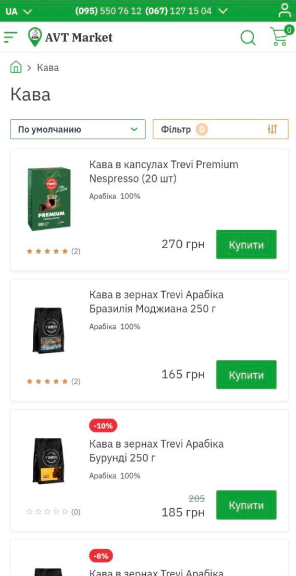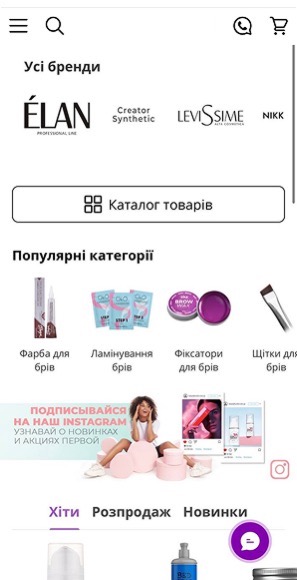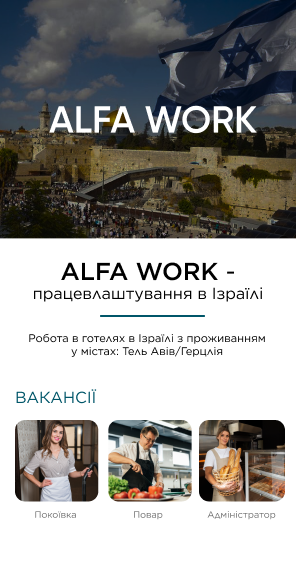Google Ads setting up for a coffee and coffee equipment store



Advertising is a powerful and fast tool for attracting targeted traffic to a website and achieving business goals.
Benefits of using PPC ads:
- increased website visibility - advertisements are shown at the top of search results and on other sites of the Google partner network, which leads to an increase in the number of clicks on ads and visits to the advertised website;
- targeted traffic - contextual advertising uses specific keywords by which users search for the desired goods or services. Thus, ads are seen by people who are interested in these products, that is, these users are more likely to convert on the site (purchase, order a callback, etc.);
- control over costs - the advertising budget is set by the advertiser, so there is complete control over advertising costs (you can set a daily or monthly budget and adjust it if necessary based on the effectiveness of the campaigns);
- measurable results - contextual advertising provides detailed analytics that allows you to track the effectiveness of ads in real-time (in the Google Ads account you can see the number of clicks on ads, cost per click, number of conversions, etc.), which helps optimize campaigns;
- fast results – after ads are moderated, ads immediately begin to appear on search results pages and other websites. That is, contextual advertising will immediately begin to bring conversions.
Let's look at the case of our cooperation with the Client - how we were able to optimize and set up new advertising campaigns to increase sales within the framework established by the owner of an online store of coffee and coffee accessories.
Coffee and coffee equipment retail store
Our Client is the online store of coffee and coffee-making equipment AVT Market. The customer contacted ITForce in July 2022 with the task of optimizing campaigns and setting up new ones in the account.
Client benefits:
- a large assortment of natural coffee products (coffee beans, coffee pyramids, drip bags, etc.);
- competitive prices of products;
- the products are always freshly fried (the Client has his own production, and raw materials are purchased first-hand);
- advanced equipment on which coffee is roasted (workers working on it received special training from the companies that produced this equipment, and coffee roasters completed courses in Spain and Ukraine);
- certificate of food safety management system ISO 22000 HACCP (HACCP);
- existing customer loyalty program;
- sending the parcel during the day (subject to payment of the order before 16:00);
- free delivery from 1200 UAH (Nova Post, Ukrposhta).
We took into account all the advantages and reflected the most important ones when setting up campaigns.
Audit of existing advertising campaigns
We started working on the client's account with an audit of already configured advertising campaigns. The audit revealed problems with the Feed, which we resolved by involving a developer.
The next stage is the optimization of existing advertising campaigns. Work we carried out on the Client's account:
- optimized smart shopping and search brand campaigns;
- set up Google Shopping and Smart Shopping campaigns;
- set up a Display Search Ads advertising campaign
We also checked and set up entire advertisements, all the necessary user audiences and a Google Analytics account. Below is more detail about our settings with justification for actions.
Advertising effectiveness a month before optimization work and the launch of our advertising campaigns (June 2022):

Fig. 1 – Advertising campaigns for the start of cooperation, June 2022
3 advertising campaigns were set up and running (2 of which were Smart Shopping and 1 search brand) in the Client’s account. Which in total brought 515 transactions with an average cost of 62.19 UAH.
During the period in which cooperation with the Client began (July 2022), Google announced an automatic transition from Smart Shopping campaigns to Performance Max.
After the agreement with the Client, we decided to prepare and create a new type of Performance Max campaign with Smart Shopping running. The goal of these actions, when you next switch to PMax, is not to lose the results that Smart Shopping has already brought. By the way, the configured Smart Shopping still works in the Client’s account.
Google Shopping and Performance Max. In addition to the running Smart Shopping campaigns (which worked with product feeds in Russian), we decided to configure standard Google Shopping and Performance Max with product feeds in Ukrainian for different product categories.
Standard shopping campaigns did not bring a sufficient number of conversions compared to Smart Shopping and PMax, so they were finally suspended after 2.5 months (except for Shopping for a certain product category).
We set up DSA search campaigns according to the Client's wishes. But they also did not bring the expected results, so after about a month we suspended them.
Brand advertising campaigns. The Client's request was to add an ad group in Ukrainian. After analyzing the keywords, it became clear to us that most queries look almost the same in both languages because the brand's name is used. That is why, to avoid duplication of keys, we decided to completely transfer the company to Ukrainian.
Conversions. The Client's account had already set up a conversion from the purchase category - Transaction, which is most relevant for advertising e-commerce websites. The only change we made was to change the attribution model for this conversion in the Google Ads account based on data.
This is what the ads for the configured campaigns look like:


Fig. 2 – Examples of ads for Performance Max advertising campaigns
We optimize campaigns on an ongoing basis:
- by excluding ineffective products from displays;
- adding new asset groups with new audience signals to Performance Max campaigns;
- suspension of less effective groups of facilities;
- adjusting company strategies (we periodically change the target ROAS or strategy (focusing on the Value of Conversions or the Number of Conversions) to achieve better results.
We are testing new audience signals. We also try to optimize the product feed for better performance of a campaign for a certain category of goods - we test segmentation by cost of goods and optimize descriptions.
The hypothesis of using Google Shopping and Performance Max
We tested the hypothesis of the parallel use of standard Google Shopping and Performance Max in working with one of the product categories. We created and used different feeds for different types of campaigns so as not to harm the optimization of each individual LCD.
We worked with this method at first, then we decided to use only Performance Max, but the advertising results worsened. Therefore, in the future, we plan to return to the parallel use of Google Shopping + Performance Max, because this strategy has proven to be better.
Our weekly work plan for optimizing advertising campaigns consists of:
- elaboration of search queries, expansion of the list of negative keywords based on non-target queries;
- adding keywords based on target queries;
- development of system recommendations to improve the account quality indicator;
- adding adaptive ads, improving the quality of existing ads;
- disabling ineffective keywords, ad group, and products in Shopping if necessary;
- disabling goods in Shopping companies and Performance Max if necessary;
- pausing ineffective campaigns and setting up new ones if necessary;
- disabling ineffective geos if necessary;
- adjusting rates and budgets as necessary;
- adding new ad extensions;
- testing automatic bidding strategies in Shopping campaigns;
- testing new audience signals in Performance Max campaigns.
Promotional offers on the Client’s website
The AVT Market Client's store introduces a monthly promotion on certain products. Also during our period of cooperation came such significant news events as Black Friday, Christmas, and New Year, March 8th. And we must display available promotional offers in advertisements.
It should be noted that promotions can only be added in search and Performance Max campaigns when displaying text ads on the Google search network. And also under certain conditions for trading (Shopping).
Stock requirements from Google Help. You must meet the following requirements to display discounted price annotations for products:
- The base or higher price must have remained the same for 30 days (not necessarily consecutive) in the last 200 days.
- The base price must be valid.
- The discounted price must be lower than the main price.
- The discount must be more than 5% and less than 90%.
We take all these requirements into account and display available special offers in advertisements. For example, this is what the promotion looked like on the website for March 2023:

Fig. 3 – Special offers March 2023
Our customer is open to suggestions, and we coordinate all new implementations and recommendations of the system together (creating new campaigns, increasing the budget, etc.). So we discuss with the Client the creation and testing of an audience segment from existing user emails.
Results of advertising campaign settings
Let's take a look at the area in which our Client, AVT Market, operates. There is data on paid traffic to the Client's website compared to overall industry traffic.

Fig. 4 – Volume of paid traffic to the website
We see that overall site traffic has improved - since the beginning of cooperation, the number of sessions has increased by 165.25%. The number of new sessions decreased by 25.13%. At the same time, the site received more new users through contextual advertising - an increase is 98.6%. Moreover, these users are targeted, because the number of page views per session has decreased, and the length of the session has increased. That is, the user clicks on the ad and goes to the site, where he views the information that interests him. And then he places the order or not.
In this context, let's look at the length of time before conversion - these are visitors who place an order some time after their first visit to the website. These could be associated conversions, a bookmark in the browser for the future during a regular search, or something else.
What do we mean by conversions in a Client’s account:

Fig. 5 – Types of conversions in the online store of coffee and coffee products account
Let's look at the time before the conversion of those users who followed an ad to the Client's website (we consider only the Paid Advertising channel).

Fig. 6 – Time until visitors convert via contextual advertising
Most visitors to a coffee and coffee accessories website complete their order by converting immediately, during their first visit to the website. The next significant group is in 1-3 days. The further away from the first visit, the fewer conversions we have. Their number increases as 30 days approach.
In Google Analytics, we looked at the number of conversions up to day 90. And no group has 100+ credited conversions over the next 60 days. In total, the figure from 12 to 89 days is 1,945, which is 22.91%, and this is a significant portion of visitors, almost a quarter of all who came to the site through advertising. And the value of the conversion increases after the 30th day; these are valuable users for the website.
The further from the first visit the greater the number of conversions becomes. Again, these can be repeat orders or orders with a discount applied:
- for example, a user views a certain product on a website;
- he is satisfied with the offer and keeps the page with the product;
- and subsequently places an order;
- or when a discount is announced for this product (and we remember that the Client provides promotional offers every month), add it to the cart to see the final price);
- and then place the order or not.
The majority of visitors take the conversion action immediately or within 3 days after clicking on the ad. But there is also a segment of users who are ready and complete the conversion within 89 days. That is, we have a significant portion of visitors who return to the website.
As of March 2023, the client has 7 advertising campaigns running. Of them:
- 3 Performance Max;
- 2 Smart Shopping;
- 1 Shopping;
- 1 branded search engine.
And below in the screenshot are all campaigns that worked from July 2022 to March 2023.

Fig. 7 – Advertising campaigns July 2022 – March 2023
Let's consider the effectiveness of campaigns by the number of transactions:
- 65.59% of transactions, equal to 57.24% of income from all contextual advertising, are brought to the client by Smart Shopping campaigns;
- 19.11% of transactions are provided by Performance Max (20.69% of income);
- 13.58% of transactions came from search brand campaigns (18.75% of all contextual income);
- 1.57% is provided by Shopping (3.25% of income);
- The client received 0.13% of transactions from DSA campaigns (0.07% of revenue).
We have the highest transaction rate out of 2 search brand campaigns - 12.22% and 11.74%, respectively. Next comes Smart Shopping with a certain product category – 8.95%. While the average account transaction rate is 4.65%.
Over 9 months of cooperation, the client’s website had 62,622 visitors and 5,220 transactions. That is every 12th visitor to the site through paid advertising completed their stay on the resource with an order. In turn, this means that visitors to the AVT Market website are predominantly targeted with a formed query for the purchase of the goods.
And if we remember the total number of conversions - 8553, and compare this value with the number of transactions, we get 61%. That is, 61% of users who converted (added an item to the cart, viewed it, or completed the order with a transaction) completed their visit to the site by placing an order. And this is more than half of all users. Our ads work and the client's landing pages meet user queries. Now let’s compare the periods before ITForce advertising settings and the current month of operation. This is June 2022 and March 2023.

Fig. 8 – Comparison of the work of the Republic of Kazakhstan March 2023/June 2022
- 44.86% is the growth in the number of users;
- 83.22% – increase in income from customized advertising;
- 11.41% – increase in average order value;
- 64.45% – increase in the number of transactions;
- 40.46% – the cost for each session has increased;
- 30.44% is the increase in profitability of advertising costs.
By optimizing existing campaigns and setting up new ones, AVT Market increased product sales by 62.74%, which accounted for 80.69% growth in advertising revenue. That is, we coped with the Client’s task - we optimized and set up advertising within the framework established by him. As the number of campaigns increased, so did their costs. The cost of the order does not exceed the planned 60 UAH. At the same time, the average figure in the account in March 2023 is 41.55 UAH.
22.91% of website visitors through the Paid Advertising channel convert within 12-89 days after their first visit to the resource. 61% of users who visited the site by clicking from contextual advertising completed their visit with a transaction.
Our big plan for the next period is to continue working with existing advertising campaigns and optimize them.




